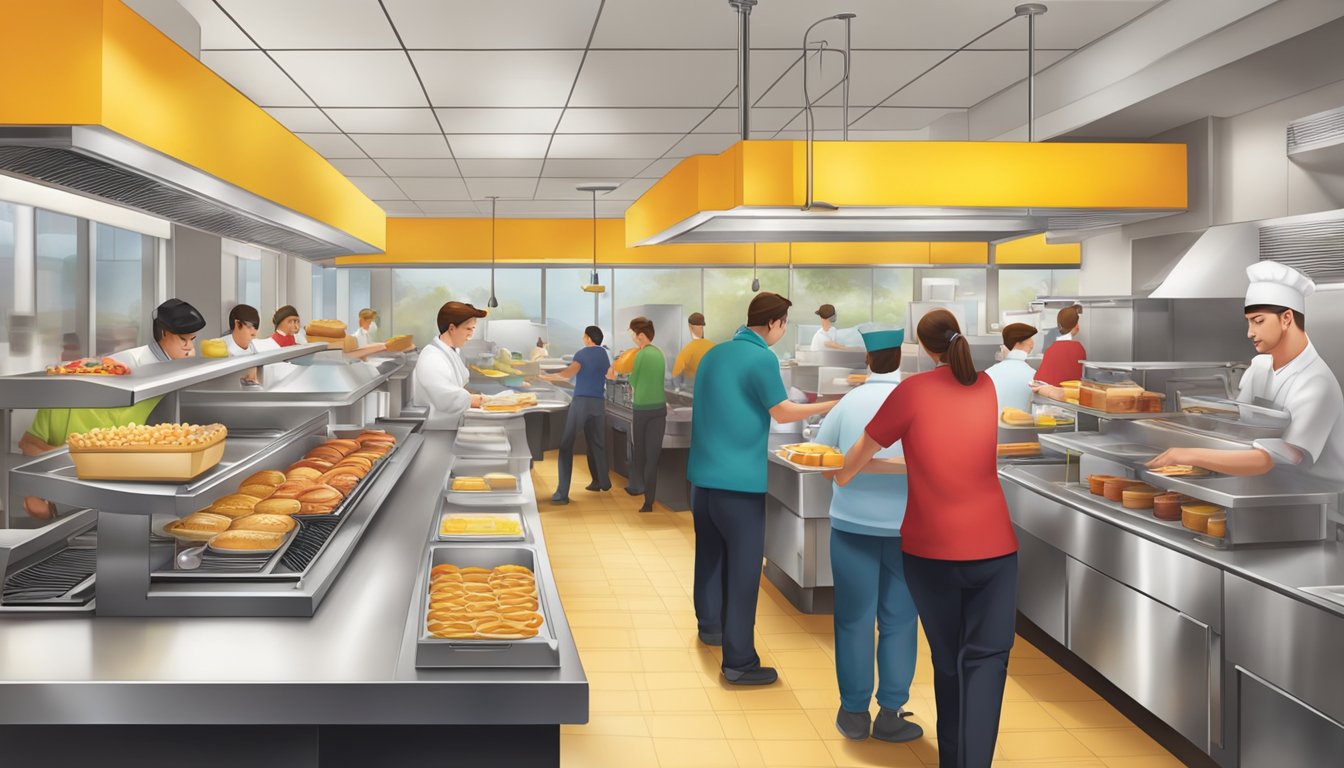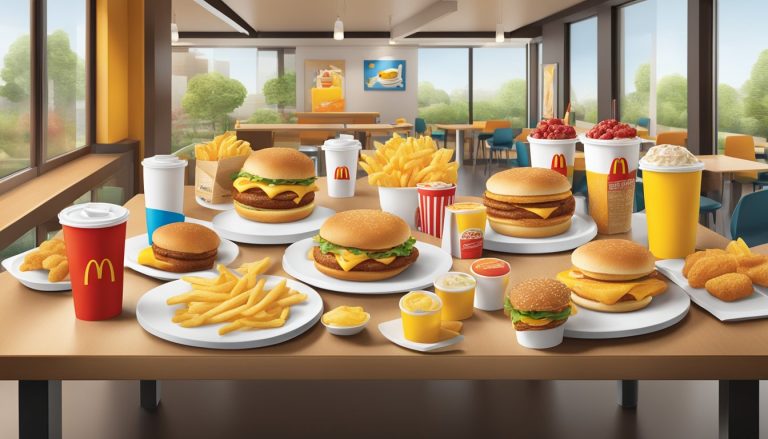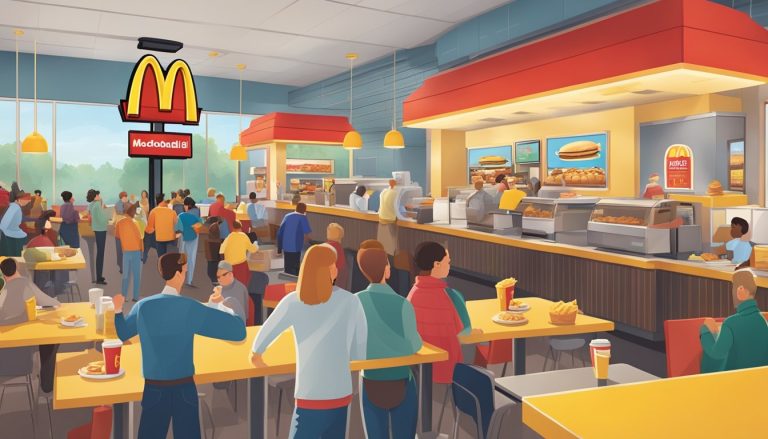McDonald’s breakfast has become an iconic part of many people’s morning routines. From Egg McMuffins to hotcakes, the fast food giant offers a variety of options to start the day. But there’s more to the McDonald’s breakfast experience than meets the eye.
Behind the counter, McDonald’s employees have gained insider knowledge about the breakfast menu and operations. Their insights can help customers make more informed choices and have a better dining experience. This article will explore some of the things McDonald’s workers want patrons to know about the most important meal of the day.
1) Employees prefer breakfast shifts
Many McDonald’s employees favor working breakfast shifts. The morning hours often provide a structured routine and predictable flow of customers. This can make the workday feel more organized and manageable.
Breakfast shifts typically start early, allowing workers to finish their day sooner. Some employees appreciate having afternoons and evenings free for other activities or commitments.
The breakfast menu is generally more limited than later meals. This can make food preparation and order fulfillment more straightforward for staff. Fewer menu options may lead to a smoother workflow during busy periods.
Morning shifts tend to attract regular customers with consistent orders. Employees can build rapport with these patrons, creating a more pleasant work environment. Familiar faces and predictable orders can make the job feel more rewarding.
For those who are morning people, breakfast shifts align well with their natural energy levels. Starting work early allows them to be productive when they feel most alert and focused.
2) Eggs are cracked fresh daily

McDonald’s takes pride in using freshly cracked eggs for certain breakfast items. Each morning, employees crack real eggs into round rings on the grill to prepare the iconic egg patties for McMuffins.
This process ensures customers receive a fresh, high-quality egg product. The round eggs are considered the freshest option on the breakfast menu by many McDonald’s workers.
For other breakfast items, McDonald’s uses different egg preparations. However, the McMuffin’s round egg remains a standout for its freshness and quality.
Customers can request the freshly cracked round eggs on other breakfast sandwiches as well. This allows them to enjoy the same quality egg across different menu items.
The commitment to using fresh eggs daily demonstrates McDonald’s focus on providing a quality breakfast experience. It sets certain menu items apart and gives customers confidence in their morning meal choice.
3) Hotcakes come from a special mix

McDonald’s hotcakes have been a breakfast menu staple since 1977. These fluffy pancakes are made from a proprietary batter mix, carefully formulated to achieve consistent taste and texture across all locations.
The exact recipe remains a closely guarded secret. However, it’s known that the mix contains typical pancake ingredients like flour, sugar, and leavening agents. McDonald’s likely uses specialized equipment to prepare and cook the hotcakes efficiently.
Each order of hotcakes consists of three golden-brown pancakes. They’re served with a pat of real butter and warm syrup on the side. This classic combination has remained largely unchanged for decades.
While delicious, hotcakes are one of the more indulgent breakfast options. A standard order contains 580 calories and 102 grams of carbohydrates. Customers can pair them with other menu items for a heartier meal.
McDonald’s hotcakes continue to be a popular choice for those seeking a sweet breakfast option. Their unique taste and texture, derived from the special mix, keep customers coming back for more.
4) Hash browns are fan favorites
McDonald’s hash browns have achieved iconic status among breakfast menu items. The crispy, oval-shaped potato patties consistently rank as customer favorites.
In a Mashed poll, McDonald’s hash browns outperformed competitors like Chick-fil-A, Burger King, and Taco Bell. They received an impressive 39% of votes, demonstrating their widespread popularity.
The golden exterior and soft interior of McDonald’s hash browns create an irresistible texture combination. Made with just eight ingredients, these potato patties manage to strike a perfect balance of simplicity and flavor.
Introduced in 1977, hash browns have become a staple of the McDonald’s breakfast menu. Their enduring popularity has even led to their inclusion in the all-day breakfast offerings at U.S. locations.
Many customers consider the hash browns an essential part of their McDonald’s breakfast experience. They pair well with other menu items, enhancing the overall meal.
5) Coffee is brewed every 30 minutes

McDonald’s takes coffee freshness seriously. Employees are required to brew a new pot of coffee every 30 minutes throughout the day. This ensures customers always receive a hot, fresh cup of coffee.
The coffee at McDonald’s is made from 100% Arabica beans. These high-quality beans contribute to the rich flavor profile that many customers enjoy. The frequent brewing schedule helps maintain the optimal taste and aroma.
Any coffee that has been sitting for longer than 30 minutes is discarded. This practice prevents serving stale or bitter coffee to customers. It’s part of McDonald’s commitment to quality and consistency across all their locations.
The 30-minute brewing cycle applies to regular drip coffee. Specialty coffee drinks like lattes or cappuccinos are made to order using espresso machines. These machines use the same Arabica beans to create a robust espresso base for various drinks.
McDonald’s coffee program also emphasizes sustainability. As of 2018, 97% of their global coffee supply was verified as environmentally friendly. This aligns with the company’s corporate commitment to responsible sourcing practices.
6) Breakfast ends sharply at 10:30 AM

McDonald’s breakfast service typically concludes at 10:30 AM sharp. This cutoff time marks the transition from the breakfast menu to the regular lunch offerings.
The 10:30 AM end time allows McDonald’s to prepare its kitchen equipment for lunch service. Grills and toasters used for breakfast items must be repurposed for burgers and other lunch menu options.
Some locations may extend breakfast until 11:00 AM, but this varies by franchise. Individual restaurant owners have discretion over exact breakfast hours.
From 2015 to 2020, McDonald’s experimented with all-day breakfast. However, this offering was discontinued, reverting to the traditional morning-only breakfast schedule.
Customers hoping to enjoy McDonald’s breakfast items should plan to arrive before 10:30 AM. After this time, the restaurant switches fully to its standard lunch and dinner menu.
7) All-Day Breakfast was a popular experiment

McDonald’s introduced All-Day Breakfast in October 2015, revolutionizing the fast-food industry. This move allowed customers to enjoy breakfast items beyond traditional morning hours, breaking long-standing mealtime norms.
The experiment proved highly successful, boosting McDonald’s sales and market performance. In the first quarter of 2016, the company reported higher-than-expected earnings, largely attributed to the popularity of All-Day Breakfast.
U.S. same-store sales growth reached 5.7%, outperforming other fast-food sandwich competitors by 2.9 percentage points. This significant increase demonstrated the strong consumer demand for breakfast items throughout the day.
The All-Day Breakfast menu satisfied late-rising customers and those craving breakfast foods at unconventional times. It became particularly popular among hungover individuals who could enjoy a McGriddle in the early afternoon.
Despite its success, McDonald’s eventually scaled back the All-Day Breakfast offering. Currently, breakfast hours may vary by location, typically ending around 10:30 or 11:00 AM. This change reflects the ongoing balance between customer demand and operational efficiency in the fast-food industry.
8) The McGriddle comes with a syrup-infused bun

The McGriddle stands out among McDonald’s breakfast offerings due to its unique bun. Instead of traditional bread, this sandwich features two small, fluffy pancakes infused with maple syrup flavor.
This innovative bun design allows customers to enjoy the taste of pancakes and syrup in a convenient, handheld format. The syrup-infused pancakes provide a sweet contrast to the savory fillings inside the sandwich.
McDonald’s introduced the McGriddle in 2003 as a portable breakfast option. The goal was to combine the flavors of a complete breakfast—pancakes, syrup, and savory ingredients—into a single, easy-to-eat item.
The creation process for McGriddle buns involves pouring a specially formulated batter onto a hot griddle. This batter contains the maple syrup flavoring, ensuring that the sweetness is evenly distributed throughout the pancake.
After cooking, the pancake buns are allowed to cool slightly before being used to assemble the sandwich. This process results in a firm yet soft texture that holds the sandwich together while providing a distinct maple flavor in every bite.
9) Custom orders are possible

McDonald’s breakfast menu offers more flexibility than many customers realize. Employees can accommodate various customization requests for morning meals.
Guests can ask for modifications like extra cheese, no bacon, or substituting ingredients. Some locations even allow mixing and matching items from different breakfast sandwiches.
For those watching their calories, egg whites can often be substituted for whole eggs. Customers can also request light or no butter on biscuits and English muffins.
Sauces and toppings are another area where customization shines. Diners can add or remove sauces, or ask for them on the side. Popular additions include extra syrup for hotcakes or salsa for breakfast burritos.
While not all modifications may be possible due to operational constraints, McDonald’s staff generally try to fulfill reasonable requests. Customers are encouraged to politely inquire about customization options when ordering their breakfast.
10) Not all locations serve the same items

McDonald’s breakfast menus can vary significantly between locations. While core items like Egg McMuffins and hash browns are usually available, other offerings may differ.
Regional preferences often influence menu choices. For example, some Southern U.S. locations serve biscuits, while others focus on English muffin-based sandwiches.
International McDonald’s restaurants adapt their breakfast menus to local tastes. In India, customers might find a Masala Dosa Brioche, while Japanese locations offer Chicken Tatsuta sandwiches.
Menu variations can also occur due to equipment limitations or ingredient availability at certain restaurants. Smaller locations may have a more limited breakfast selection compared to larger stores.
Seasonal items and limited-time offers further contribute to menu differences between McDonald’s locations. These temporary additions may only be available in specific regions or countries.
Franchisees sometimes have the flexibility to customize their breakfast menus based on local demand and preferences. This can result in unique items appearing at individual restaurants.
11) Muffins are baked in-house

McDonald’s takes pride in serving freshly baked muffins to their breakfast customers. These delectable pastries are prepared on-site at each restaurant location.
The process begins early in the morning as staff members mix the batter and prepare the ovens. They carefully portion the batter into muffin tins and place them in the ovens to bake.
The aroma of freshly baked muffins fills the air as they cook to golden perfection. Once done, the muffins are removed from the ovens and allowed to cool slightly before being served.
This in-house baking ensures that customers receive warm, fresh muffins with their breakfast orders. The practice also allows McDonald’s to maintain consistent quality across all locations.
Baking muffins on-site gives McDonald’s employees the ability to monitor the baking process closely. They can adjust cooking times or temperatures as needed to achieve the ideal texture and flavor.
12) The Egg McMuffin was the first breakfast item

The Egg McMuffin holds a special place in McDonald’s history as the pioneering breakfast item. Introduced in 1972, it marked the beginning of the fast food giant’s foray into the breakfast market.
Herb Peterson, a McDonald’s franchise owner in Santa Barbara, California, created this innovative sandwich. He was inspired by eggs Benedict but wanted a more practical option for fast food service.
Peterson replaced the traditional Hollandaise sauce with a slice of cheese and used a toasted English muffin as the base. The addition of Canadian bacon completed the now-iconic breakfast sandwich.
The Egg McMuffin’s success led McDonald’s to officially launch a full breakfast menu in 1977. This menu included other items like hotcakes, scrambled eggs, sausage, hash browns, and Danish pastries.
Today, the Egg McMuffin remains a popular choice on McDonald’s breakfast menu. While its appearance may have evolved slightly since 1972, its core components and appeal have stood the test of time.
13) Bacon and sausage are pre-cooked

McDonald’s breakfast menu features bacon and sausage that arrive at restaurants already cooked. This pre-cooking process is standard across all McDonald’s locations worldwide.
The bacon used in breakfast items is prepared by McDonald’s food supplier, OSI Group. It comes pre-cooked and is reheated on the grill when ordered by customers.
Sausage patties also arrive at McDonald’s restaurants in a pre-cooked state. This allows for quick preparation during busy breakfast hours while maintaining consistency in taste and quality.
The pre-cooking of bacon and sausage helps McDonald’s serve breakfast items efficiently. It reduces cooking time and ensures that these popular breakfast meats are always ready for customers.
This practice allows McDonald’s to maintain food safety standards and deliver a consistent product across all locations. It’s part of the company’s strategy to provide fast service without compromising on taste or quality.
Secrets Behind McDonald’s Breakfast Menu
McDonald’s breakfast menu contains some surprising elements that many customers may not be aware of. The ingredients and item selection process involve more complexity than meets the eye.
Special Ingredients Used
McDonald’s uses a proprietary blend of oils for cooking its breakfast items. This mixture gives foods like hash browns their signature crispy texture and flavor. The eggs in breakfast sandwiches often come from liquid egg products rather than whole eggs cracked on-site.
For biscuits and griddle cakes, McDonald’s employs a special batter that allows for quick cooking while maintaining a fluffy interior. Sausage patties contain a custom spice blend developed specifically for the chain’s breakfast menu.
How Items Are Selected for the Menu
McDonald’s relies heavily on market research and customer feedback when choosing breakfast offerings. Items must meet strict criteria for taste, preparation time, and profit margins. The company conducts extensive testing in select markets before rolling out new breakfast products nationally.
Seasonal promotions play a key role in menu selection. McDonald’s often introduces limited-time breakfast items to generate buzz and drive sales. Regional preferences also factor into menu decisions, with certain breakfast items available only in specific areas.
Health trends influence the selection process as well. In recent years, McDonald’s has added more nutritious breakfast options like oatmeal and fruit & yogurt parfaits to appeal to health-conscious consumers.
Behind-the-Scenes of Breakfast Preparation
McDonald’s breakfast preparation involves a mix of pre-made ingredients and efficient assembly processes. Staff manage high-volume periods while adhering to strict quality standards.
Peak Hours and Demand Management
Breakfast rush typically occurs between 6-10 AM. Staff arrive early to prep ingredients and equipment. Managers forecast demand based on historical data and local events.
During peak times, employees work in specialized stations. Some focus on grilling, while others assemble sandwiches or package orders. This assembly line approach maximizes efficiency.
Hot items like eggs and sausage are cooked in batches. Pre-packaged ingredients such as pancakes and burrito mix are heated as needed. Staff constantly restock supplies to avoid running out during rushes.
Drive-thru orders often take priority due to time constraints. Inside, digital menu boards and self-service kiosks help manage customer flow.
Training and Efficiency Tactics
New hires undergo rigorous training on food safety and preparation techniques. They learn standardized procedures for each menu item to ensure consistency across locations.
Employees practice speed drills to improve order assembly times. Managers track metrics like order accuracy and preparation speed, providing feedback to staff.
Cross-training allows workers to rotate positions as needed. This flexibility helps manage unexpected rushes or staff shortages.
Technology plays a key role in efficiency. Kitchen display systems show pending orders and track preparation times. Automated cooking equipment, like egg cookers, helps maintain quality while increasing output.




